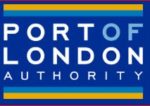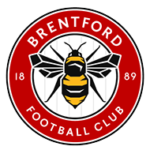|
|
7th – 9th October 2011
My adventure began on Thursday 6th October and I still get a strong heartbeat every time I see a photo of Old Harry – I definitely must see him again – soon!
It all started in Lot’s Road Pub that Thursday evening, when 10 enthusiastic sea kayak paddlers met in order to plan the last details of our trip to Dorset the following weekend.
The weather forecast was quite bad – strong winds from west (F5>7 Beaufort) was expected and the planned route from Swanage Bay to Kimmeridge Bay might be too big a challenge and too dangerous in these weather conditions.
The route had to be picked carefully because even in calm wind it can be a difficult and exposed trip with a quite strong flow going east on the flow and west on the ebb. And once past Duriston Head, there is no stopping and often no landing until Chapman’s Pool.
So we had a very interesting, instructive and loud discussion around the table! Everybody’s opinion was heard – the brave and experienced paddlers as well as the more inexperienced or faint hearted (me)  . And I must admit that I changed my mind several times during the discussion, when new views came into consideration ;-). . And I must admit that I changed my mind several times during the discussion, when new views came into consideration ;-).
But at last we decided to pick a route along the east coast that would be relatively protected against the strong wind. And this route passed by Old Harry Rocks!
Friday late afternoon I left Bromley – with my beloved kayak on the roof rack, all the shopping for the weekend in the trunk and a brave passenger next to me (he was supposed to show me the way and ensure that I wasn’t lost in traffic as I usually am  Thank you so much, Jonny!). Thank you so much, Jonny!).
Approximately 4 hours later we arrived at the wonderful Bungalow that we had rented for the weekend. Almost everybody had arrived and we had a lovely evening together – eating Chinese takeaway and having a couple of drinks, before heading to bed.
The next morning we woke up to an irresistible smell of bacon, eggs and toast, prepared by Jonny and Alastair who had been up since 6 o’clock watching a Rugby Game  . .
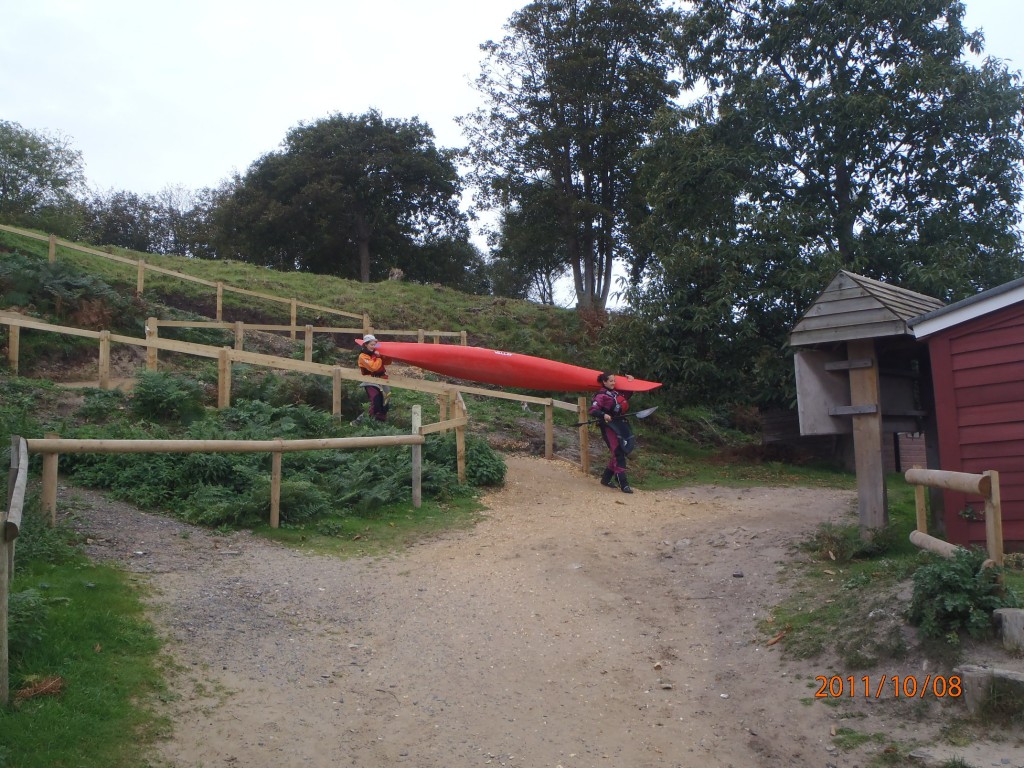
At 9.30AM we arrived at a carpark on the hill at Studland Beach, where we had quite a carry down to the beach (we didn’t see the slipway down to the water’s edge where we could have dumped the kayak’s before parking ;-)). So we were perfectly warmed up when we launched the boats heading for Old Harrys Rock, Swanage Bay and a play around Peveril Point if the weather conditions allowed it.
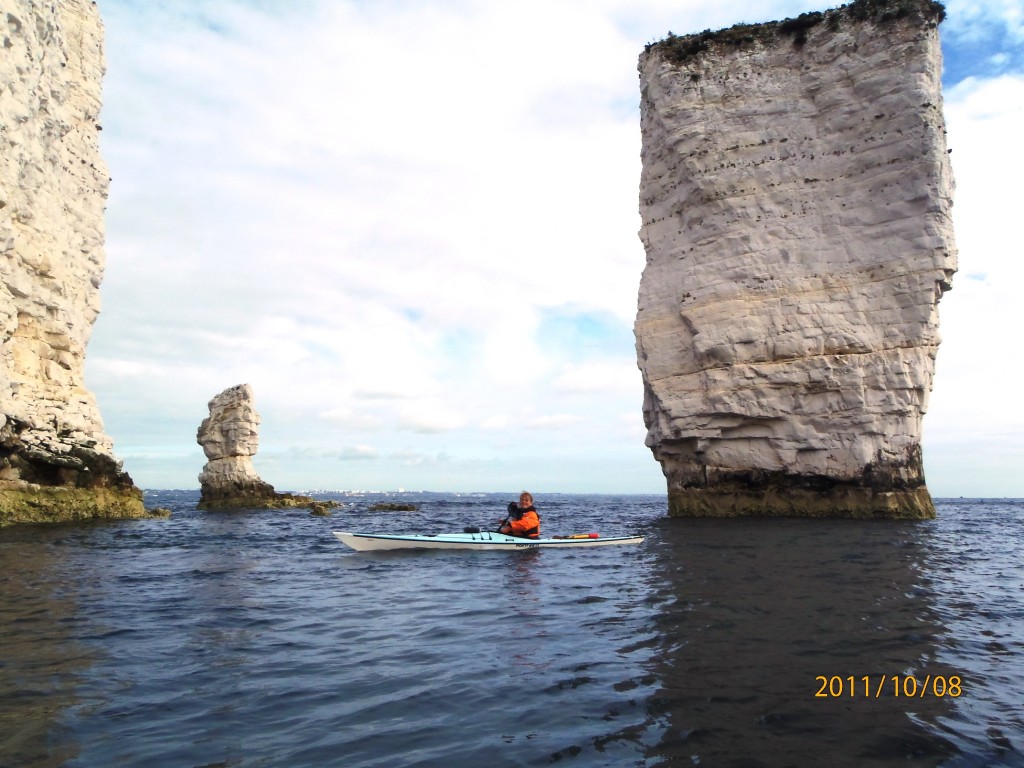
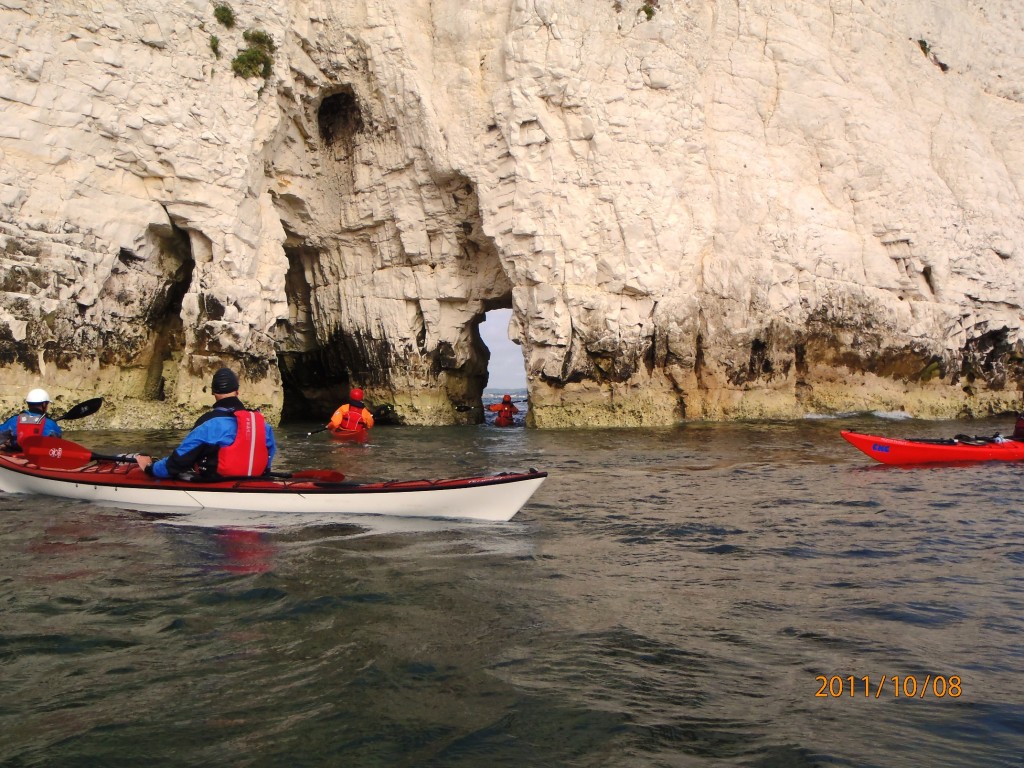
For the next 3 hours I was in another world! Enjoying the bright clean water, the strong wind and the beautiful, beautiful views of the chalk cliffs! I will never forget the first view of Old Harry Rock – strong, proud and steady – It was breath taking!
We spend an hour playing around in the caves, exploring the cliffs and trying to get through the narrowest arcs we could find. But then Stu’s stomach started to roar and we headed towards Swanage Bay and the best Fish and Chips along the east coast (according to Stu)  . .
On the way we almost lost our Chef (and Birdsman) when he caught sight of a young Perigrine Falcon, sitting in its nest on the cliff – crying after the parents, who was out of sight. Paul was determined to stay until the parents arrived – and he talked so very touchingly about this bird, which is the fastest creature on the planet – it can dive at over 200 miles per hour!
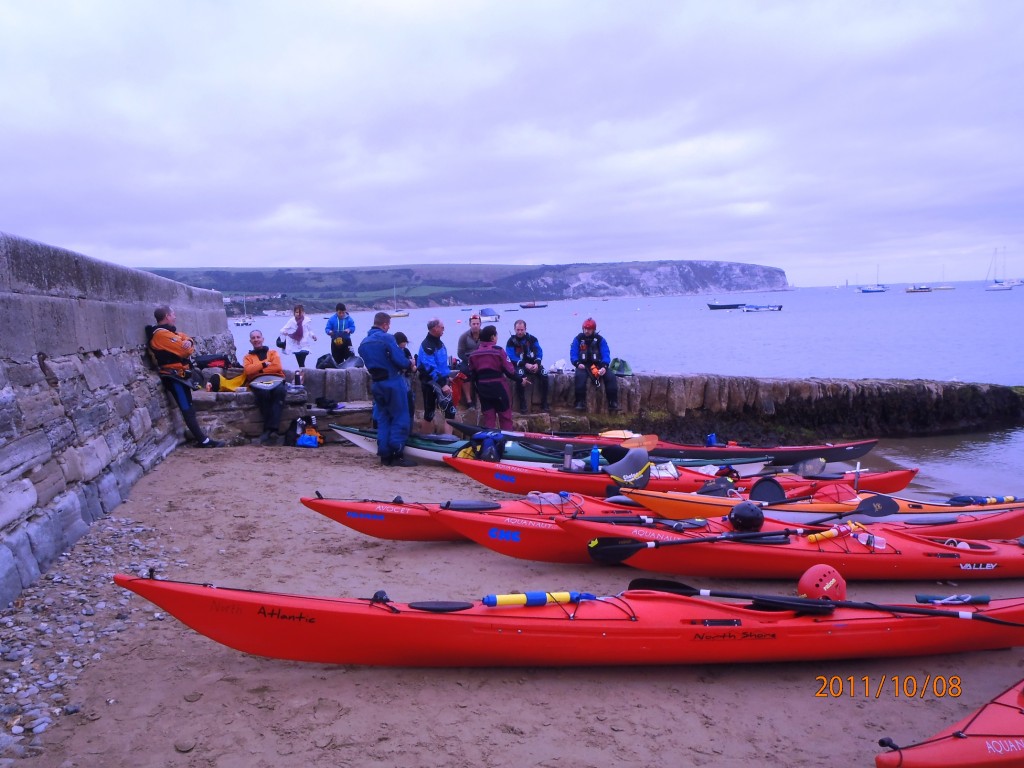
After a perfect and sunny lunch break in Swanage, we headed towards Peveril Point.
It was big fun to paddle in the lovely unstable waves and to feel the smooth swell that came from far away. The cliffs were beautiful and rough and everybody enjoyed being so close to this fabulous coastline. We spent some time exploring the rugged cliffs and I had the feeling that nobody really wanted to leave the wonderful place again.
But the clouds were accumulating and the wind was getting stronger, so we decided to call it a day and head home again. With the wind behind us we were almost blown back to Old Harry and we only had to fight against the wind the last bit from Old Harry Rock to Studland Bay. Back in the Bay we still had some energy left, so we spend another hour playing – on and in the water – some doing rolling exercises and others just fooling around  . .
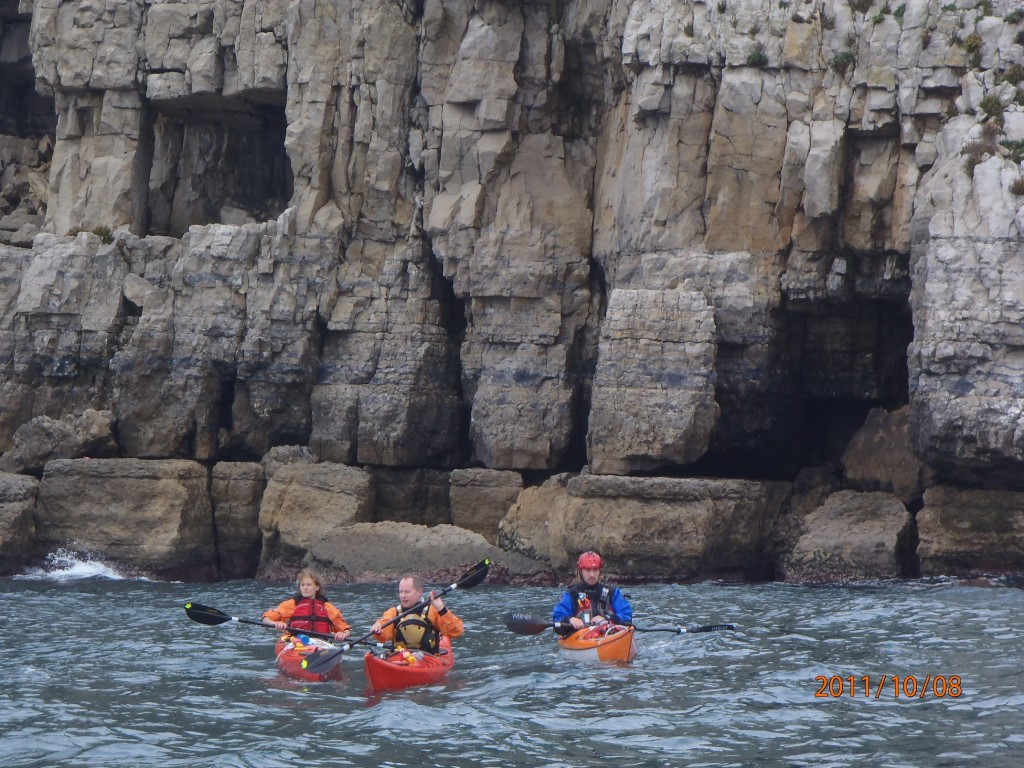
Saturday evening was gorgeous! Playing fresbee and drinking tea (or whatever  ) until sunset and then everybody was occupied by cooking the most fabulous dinner I’d had for a long time! Paul was in charge of producing a fantastic Fish Pie and Fiona brought apples for a delicious Apple Crumble Recipe! And I trust that I wasn’t the only one who could hardly eat anything the next day. ) until sunset and then everybody was occupied by cooking the most fabulous dinner I’d had for a long time! Paul was in charge of producing a fantastic Fish Pie and Fiona brought apples for a delicious Apple Crumble Recipe! And I trust that I wasn’t the only one who could hardly eat anything the next day.
Sunday morning the wind was a lot stronger than the day before, so we decided to split the group. Michal, Alastair and Martin went for a bigger challenge near Kimmerige and the rest of us went to launch at the more sheltered Studland Bay in order to do the gorgeous trip from the day before once again.
That was a good decision, because we had a very different experience this time due to the strong wind. It was a nice but strong paddle against the wind and some of us would definitely have had troubles coping with the conditions on the other side of Peveril Point! So I think everybody was happy with their choice of route and we had another enjoyable day on the water!
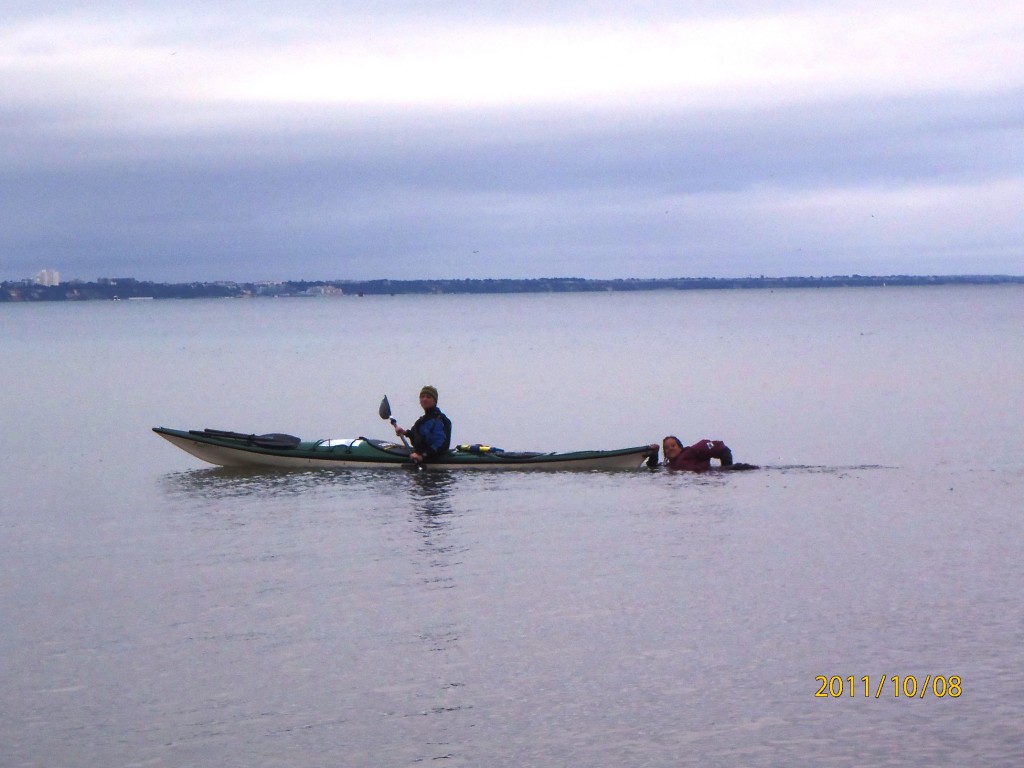
At 4 o’clock we were back at Studland Bay where we again spend some time on doing rescue and rolling exercises (thank you for coaching, Stu!) Finally we finished a perfect weekend with having a swim in the cold but lovely sea before we loaded the trailer and the cars and headed home again!
On the way home I was continuously dreaming about my new love, Harry. I felt high and happy and would definitely have burst into singing, if it wasn’t for my poor passenger, who had quite a hard time already, keeping me and the car on the road!
But I can’t wait until I will see Old Harry again (in November?)!
Thank you Fiona, for an excellently organized trip!
Pia (The “Danish”  ) )
For all of you who didn’t make it down to the open day at Cremorne Riverside yesterday, where Desperate Measures (the canoe shop) had loads of kit for us to play with (and buy), you’ll probably want to click here to read up on what you missed. But in a nut shell, there was lots and lots of kit fondling on one side of the deck, while the Friends of Cremorne Riverside and Kayaking London teams put on a whopping BBQ on the other, to make sure we needed to try on the larger sizes!
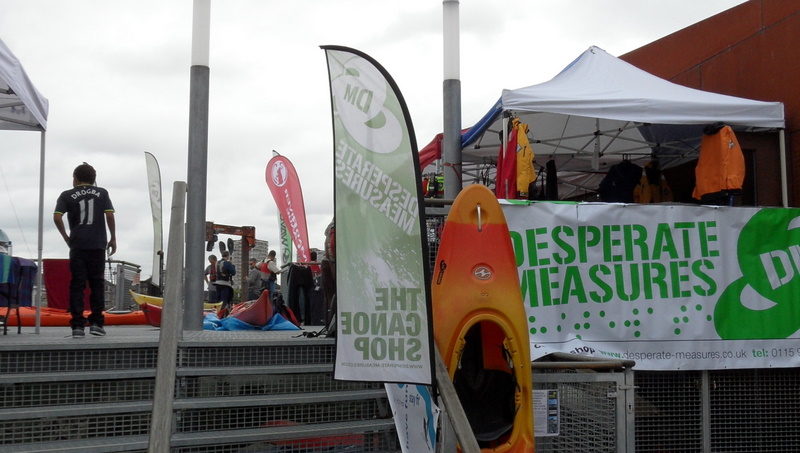
I for one am sure stoked with my new Sweet helmet, Palm buoyancy aid and Teva water shoes 🙂 and unless I’m mistaken, Geoff had his eye on one of the new breed of sea kayaks they had there to demo… but I guess we’ll have to wait and see.
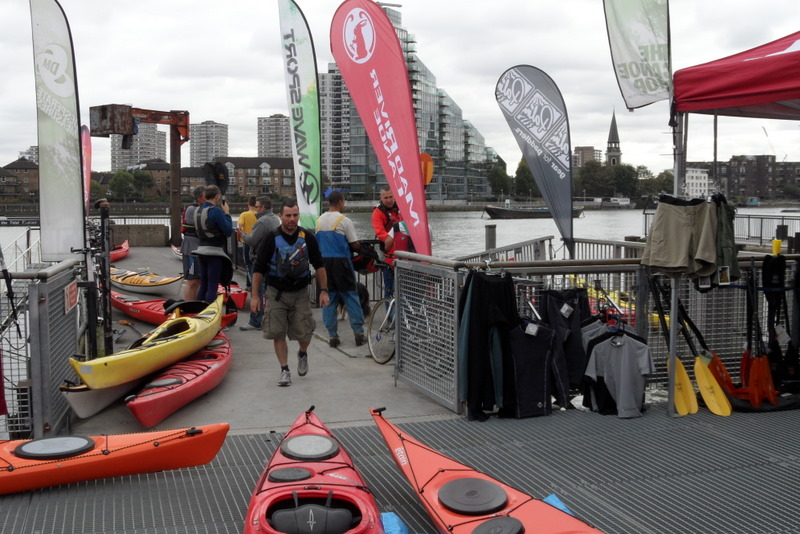 It seemed to be a great success and, hopefully will be the first of many visits by the guys at Desperate Measures – so make sure you come along to the next one. It seemed to be a great success and, hopefully will be the first of many visits by the guys at Desperate Measures – so make sure you come along to the next one.
Judes
Four CKC paddlers today picked up their ‘VHF Licence’ after a full-on day at the Timuna Sea training centre Canary Wharf, squawking “Mayday, Mayday, Mayday” in to a range of short range radios. The course, endorsed by the Royal Yachting Association (RYA) is required for anyone who wishes to use a Digital Selective Calling (DSC) radio or VHF when on the water or at sea.
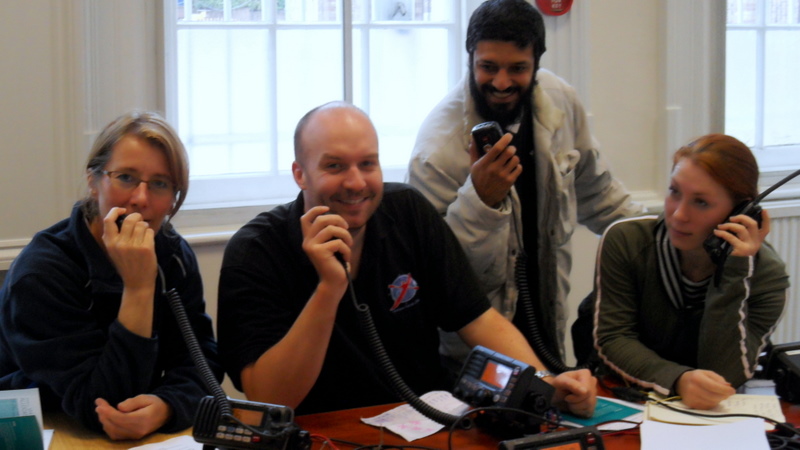
Although, as sea kayakers, we’re unlikely to be using a fixed digital station or even a digital handheld (there’s currently only one available, the Standard Horizon HX851E) it was still good to understand the principles and know what to do if ever we found ourselves in an emergency situation. And of course, it’s important for our own club’s safety that people can use the analogue VHFs that CKC uses when on trips and on the river Thames and to understand the priority of distress calls and how to make them.
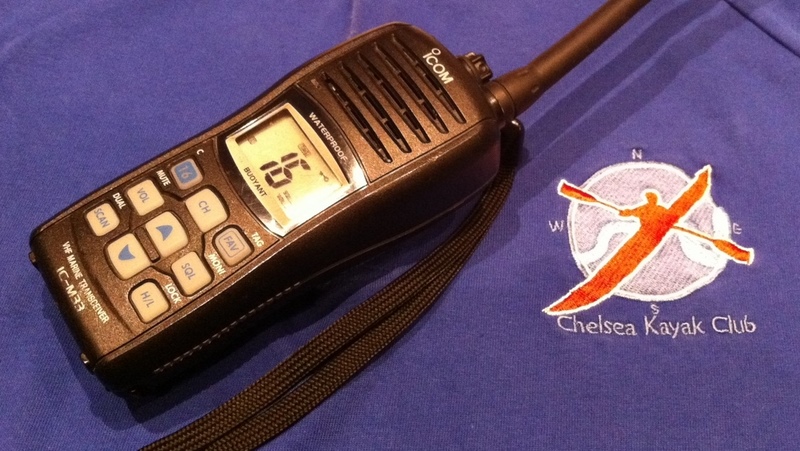
The course covered all the basics of operating various VHF units, understanding aerial range and likely shore and boat-to-boat pick up, as well as identifying correct channels and the importance of ProWords (the radio lingo). So, should there ever be a Mayday, Pan Pan or Securité alert we should know what to do – rather than just gawp at the speaker and think “I thought they just said that in the movies!?”
This was the first in the latest round of bespoke VHF training courses tailored for sea kayakers set up by our training officer, at considerable discount to CKC members – the next will take place at the end of the month.
John
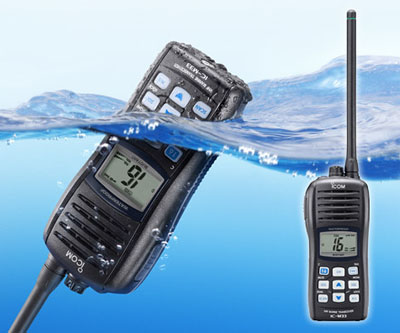 Recently my VHF radio stopped charging. The charger flashed orange when the handset was put in to charge and after a 4 hours had not charged at all. UK Rivers Guide to the rescue again. The flashing orange means there is a charging error (not actually made clear in user manual). A quick clean of the connector with some fine wire wool (I actually used a pan scourer) fixed the problem. Recently my VHF radio stopped charging. The charger flashed orange when the handset was put in to charge and after a 4 hours had not charged at all. UK Rivers Guide to the rescue again. The flashing orange means there is a charging error (not actually made clear in user manual). A quick clean of the connector with some fine wire wool (I actually used a pan scourer) fixed the problem.
Someone I met during the IOW Sea Symposium had trouble with the ICom Radios before and advised me to put some vaseline on the center connector before going out on the sea to prevent corrosion. This advice I promptly ignored, only to find on my next trip the battery was dead. So I thought I’d pass on the wisdom as I know it’s our club radio of choice.
Toons.
Whether you’re planning on ‘changing your shoes’ or ‘taking your trowel for a walk’ there’s no getting away from that call of nature when you’re out in the back of beyond on a paddling expedition – no matter what you call it. Admittedly those are two of the more polite terms we’ve had knocking around Chelsea Kayak Club in the past few years whenever we’ve been on extended wild camping tours – but when it comes to the crunch, there are no toilets on these barren coastlines so you’re basically pooing in a hole behind a bush somewhere!
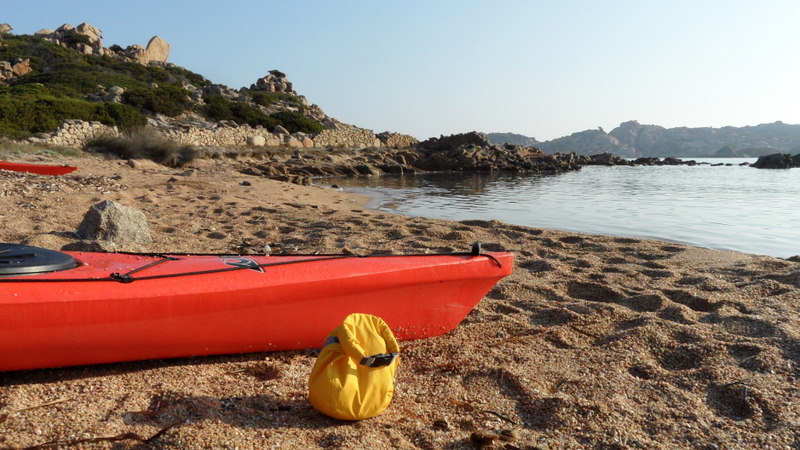
This probably isn’t the blog you want to read whilst eating breakfast, but I thought it would be educational for many a paddler anyway, so here goes, the CKC guide to shitting in the woods*:
- Get yourself an easily identifiable dry bag, which is exclusive for this purpose, for your essential hygiene kit (toilet tissue, water-free hand sanitizer and wet-wipes) – small and bright would be my suggestion, so that it can pack into a day hatch easily and can be seen better when you’re fumbling around your tent in the middle of the night.
- A tough yet compact and light trowel should be either in or connected to the bag. It’s customary to bury your business, so as not to spoil the local scenery (and to aid decomposition), so a trowel for digging your initial hole in dry, rocky soil is preferable to using your hands.
- Keep it clean – the last thing anyone wants to do is carry kit that smells of you know what, so, when you’re done squatting; fill the hole back in using the excavated debris. Note that your trowel doesn’t actually ever come into contact with any poo.
- Mark your loo spot. You’ll be out with other paddlers who, like you don’t have the luxury of a tiled bathroom or ceramic toilet to sit and do the crossword on, therefore if you’ve already found a nice, discreet spot with a stunning view – chances are they’ll be heading in the same general area too, and nobody wants to be digging up what you left behind! The standard ‘good practice’ is to stick a twig into the ground where you’ve been, so that it stands out like a little flag pole, failing that, pile a few stones/rocks on to each other.
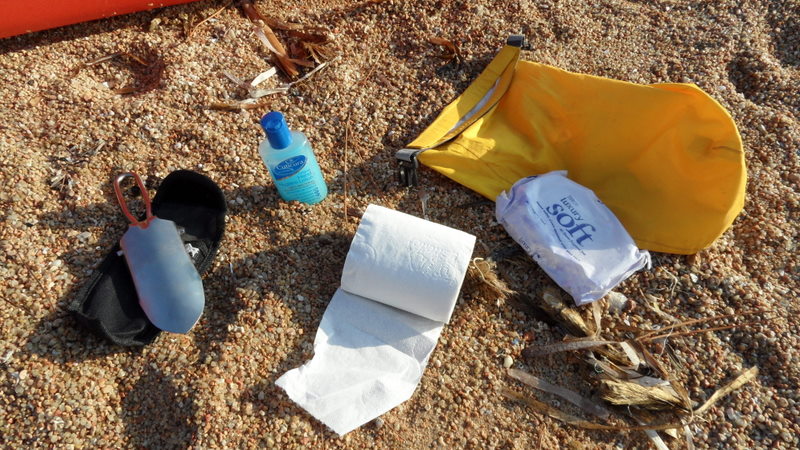
I’m sure that there’s lots of science behind exactly where you should go (above/below the water line) and how deep you should dig – but it really all comes down to how desperate you are doesn’t it? Remember that we’re there to enjoy the environment, landscape and scenery – not to spoil it for others, so keep waste to a minimum and be considerate of those who will visit in the future.
*There’s actually a lot of thought that’s gone into the official guide to defecating in the wild, but ours is more real – and what actually happens.
John
Chelsea Kayak Club got into a celebratory mood this Saturday for the The Mayor’s Thames Festival when we took part in a massive parade of boats down the river, amid cheers from the crowded banks and bridges.
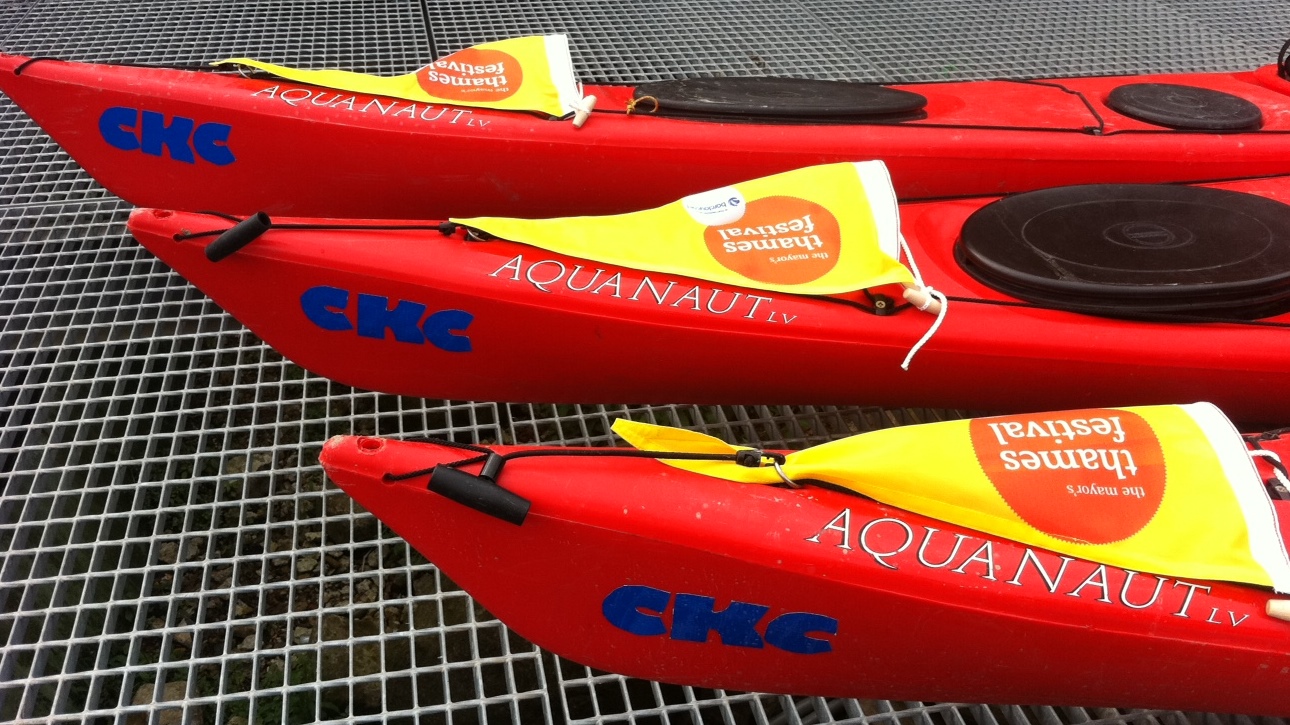
The annual Thames Festival celebrates everything special about this great waterway, but this year something special happened; the Port of London Authority hosted a flotilla of boats – both manned and powered through the heart of the capital. Boats with bells, whistles, trumpets, Dixie and brass bands heralded the arrival of the 100+ flotilla and called the people to the riverside to watch the precession go by, which included a massive water-jet boat, spraying high into the air.
In truth, despite being impressive in its own way – this was nothing but a watered-down rehearsal for The Queen’s Diamond Jubilee Pageant next year when a thousand boats will be loaded with well-wishers and decorated with flags and streamers to pay tribute to Her Majesty in celebration of sixty years as our monarch.
This is the second rehearsal that I’ve been lucky enough to help out with – the last one was specifically a kayak rehearsal – but this time, all the pieces were put together, to see how it would pan out on the big day.
Of the 11 kayaks taking part in the Thames Festival flotilla, an impressive eight of them were Chelsea Kayak Club members with a couple of people from Tower Hamlets and KayakingLondon making up the numbers. We met at Cremorne Riverside early to receive a briefing from Darren Knight, PLA’s Operations Coordinator, then jumped in the boats and paddled up river to the Hurlingham Yacht Club’s Broomhouse Pier – which was our designated muster point.
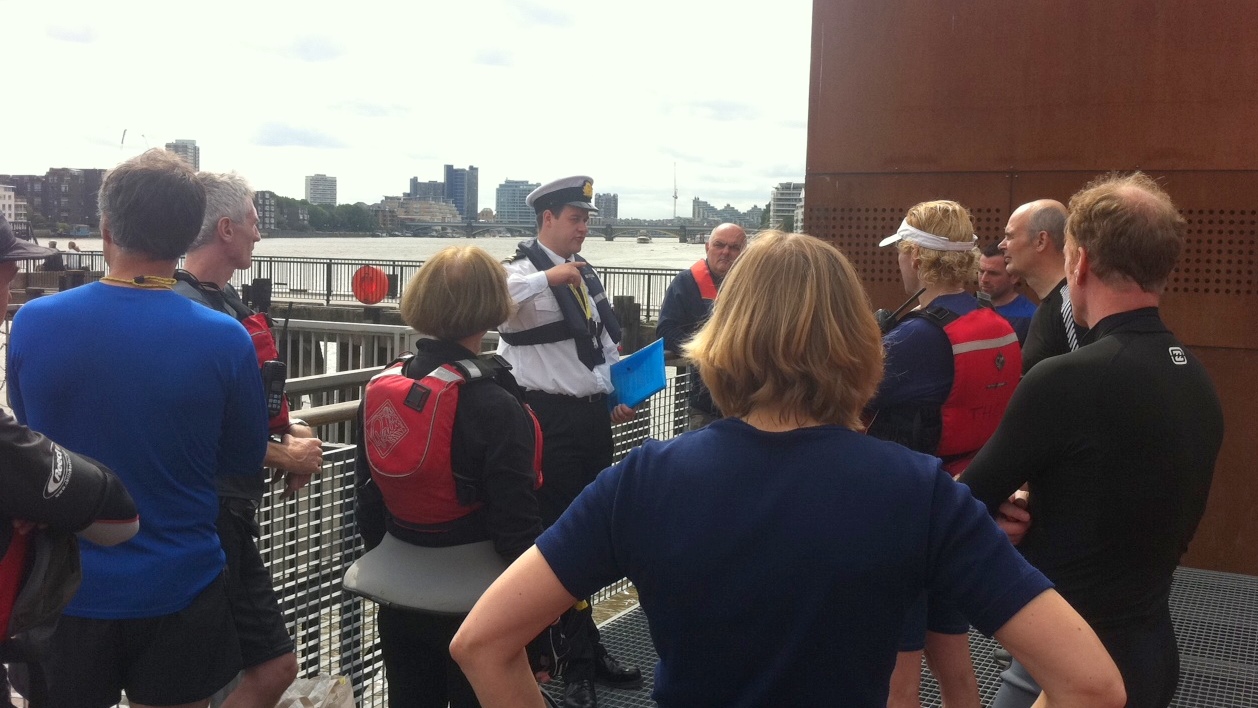
We were to join at the front of the precession, after the main ‘Belfry Barge’ that chimed its way towards the sea and after the rowing boats – which to my surprise weren’t sculling sixes or eights but old fashioned cutters – with little canopies! When we finally got started it soon became obvious that these pretty-but-bulky boats didn’t have the manoeuvrability to keep tight formation and our nimble solo sea kayaks soon shifted ahead to follow the marker vessel which was cruising at a comfortable 6 knots over ground.
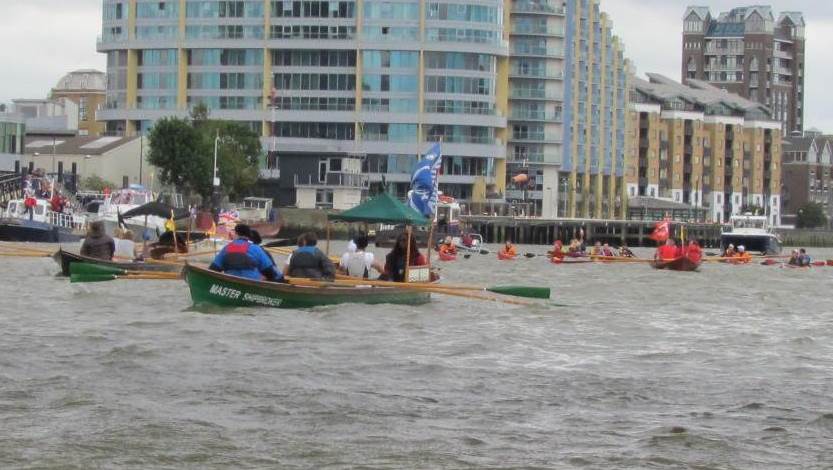
Thankfully, the lessons learnt from the last rehearsal had been headed and the longer delay between high-tide and starting out meant that keeping the 6 knot speed was pretty easy, thanks to the ebbing current. So much so, that we were even able to orchestrate some off-the-cuff synchronised paddling moves – including high speed end-boat crossovers to mix up our neat line of boats bobbing along abreast of each other.
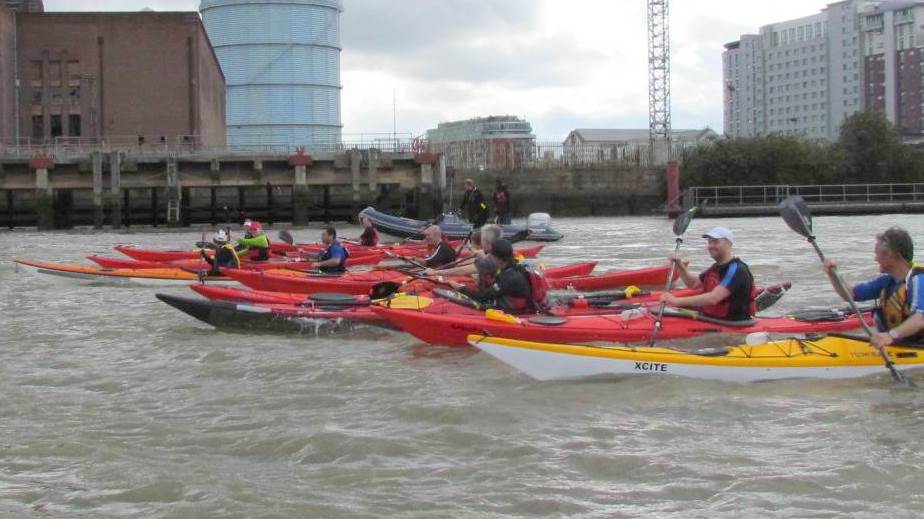
It was with big smiles on all of our faces that we first encountered the gathering crowds in the centre of town. All along the South Bank; bands, stalls and performers were entertaining Londoners and, as we followed the Belfry under the bridges we waved back to the people, whooped and spun our paddles to make them cheer. Although in honesty I think we were only small-fry compared to bigger boats that were trailing behind us.
The majority of people we saw were gathered around Tate Modern and on the Millennium Bridge, just as the river was getting that much choppier and chunkier to paddle – but even so, we held our formations and waved to the watchers. It was shortly after that we heard the cries of “Rescue, Rescue” from the fast approaching rowing boats behind, as they tried to get the attention of the safety RIBs to either side of our little collection of kayaks. It transpired that a small three man open canoe, which was part of the ‘rowing’ squad had not been so lucky with the large breaking waves under London Bridge and the paddlers were now swimming in the Thames – oops.
It goes to show how easily the waves can pick up on this stretch of tideway and local knowledge and experience, as well as appropriate boats are a must. It wouldn’t be seemly to have people in the water (or falling under HMS Belfast) when The Queen is in attendance next year. Being regulars on this river, we all knew what to expect and maintained our tight group as we passed beneath Tower Bridge and onwards to our get out at Shadwell Basin.
We started our paddle-proper by the London Helipad at Battersea and, over the course of an hour covered 11km – or so I was told by the man with the GPS as we sat in the Prospect of Whitby drinking a couple of pints to another great day sea kayaking and to being part of the London celebrations.
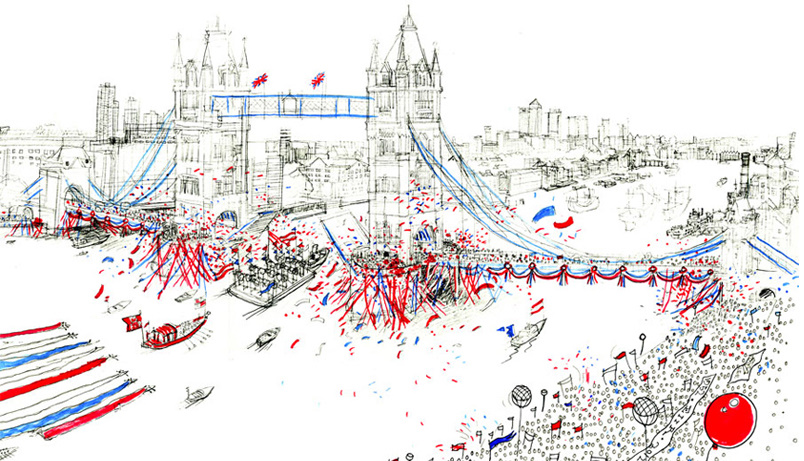
For The Queen’s Thames Diamond Jubilee Pageant they’re hoping to have ten times the number of sea kayaks taking part in the flotilla on 3 June 2012 – as yet, none of these spaces have been allocated. Anyone who wants to take part needs to apply via the website before 31 October to be in with a chance of being selected. It should be an awesome day and, one that will only come about once, so make sure you send off your details asap.
John Mayne
August Bank Holiday Weekend, 2011
Six of us from the Club (Jac, Toons, Miranda, Debs, Ann and I) attended the inaugural Isle of Wight Symposium which took place over August Bank Holiday weekend. The Symposium, organised by Isle of Wight Sea Kayaking, was put on to to fill a bit of a gap given that the Jersey Symposium will most likely not be happening anymore.
45 sea kayakers and some of the UK’s top sea kayaking coaches descended on the island for a long weekend of wet and dry workshops including practical navigation, open water tidal planning, incident management, rolling clinics, expedition skills, 4 Star Leadership Practice, boat repairs, forward paddling and intermediate handling skills.
This was my first symposium and to be honest I’d always been a bit reluctant to go on one before because of a perception that they’re a bit “cliquey” or perhaps more appropriate for the seasoned sea paddler. But I have to say there was a great atmosphere over the three days and everyone was very friendly and approachable.
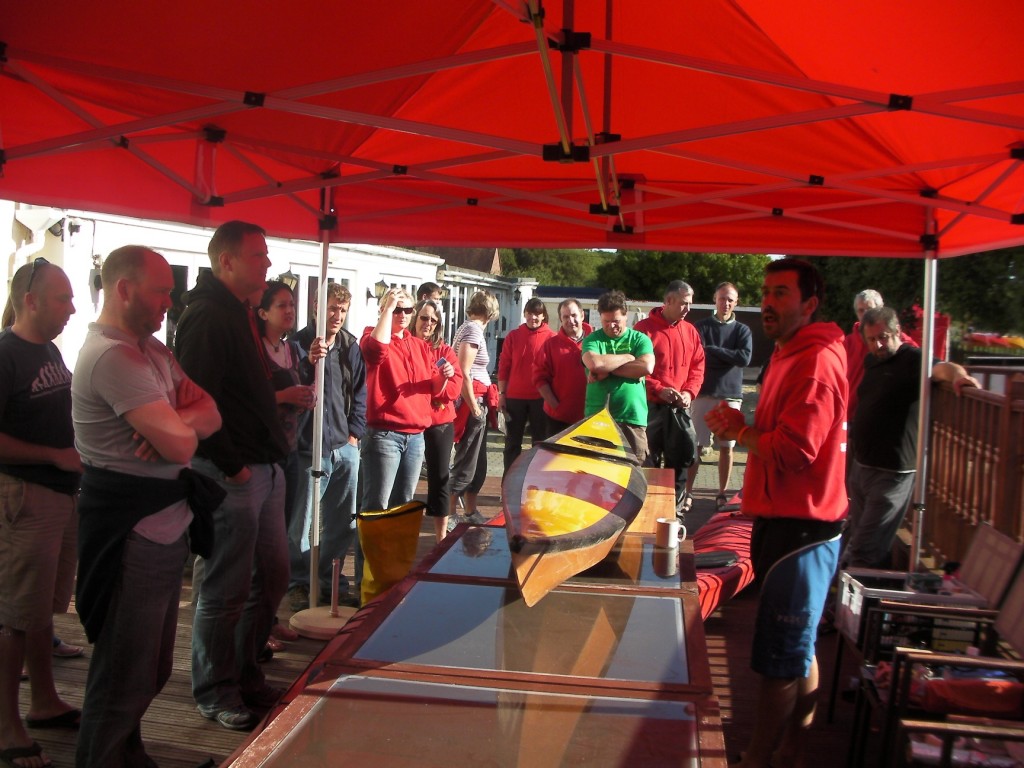
The first day (Saturday) saw most of us from the CKC contingent doing practical navigation in the morning from Fort Victoria – it was certainly interesting conditions out on the Solent – it certainly was shifting! Miranda and I were in a group with James Bachelor who used white-water analogies to get the group, each taking turns to lead, to navigate over to Hurst Castle Spit. After a bit of discussion the group decided that getting back to Fort Victoria may be a bit challenging so it decided to ferry glide through the tide race into Colwell Bay to be shuttled back. In the afternoon we did a 4 Star Leadership session with Kate Duffus and James Bachelor out in Freshwater Bay in conditions approaching the top end of the remit.
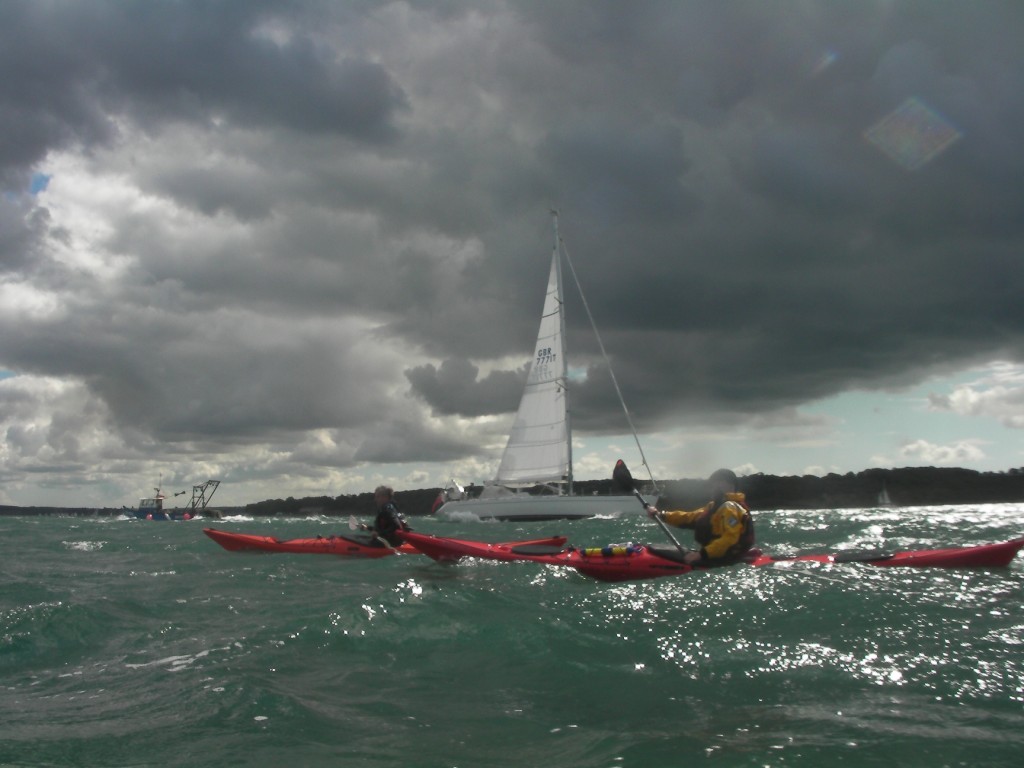
Whilst all the sessions I attended were good, I have to say that the one of the best sessions was the boat repairs workshop led by the great Howard Jeffs. Lots of great handy hints and tips – I believe Miranda may be writing a blog up on this soon (so watch out for that!). Valley were also on hand and they helped us fix one of the Club boat’s skegs.
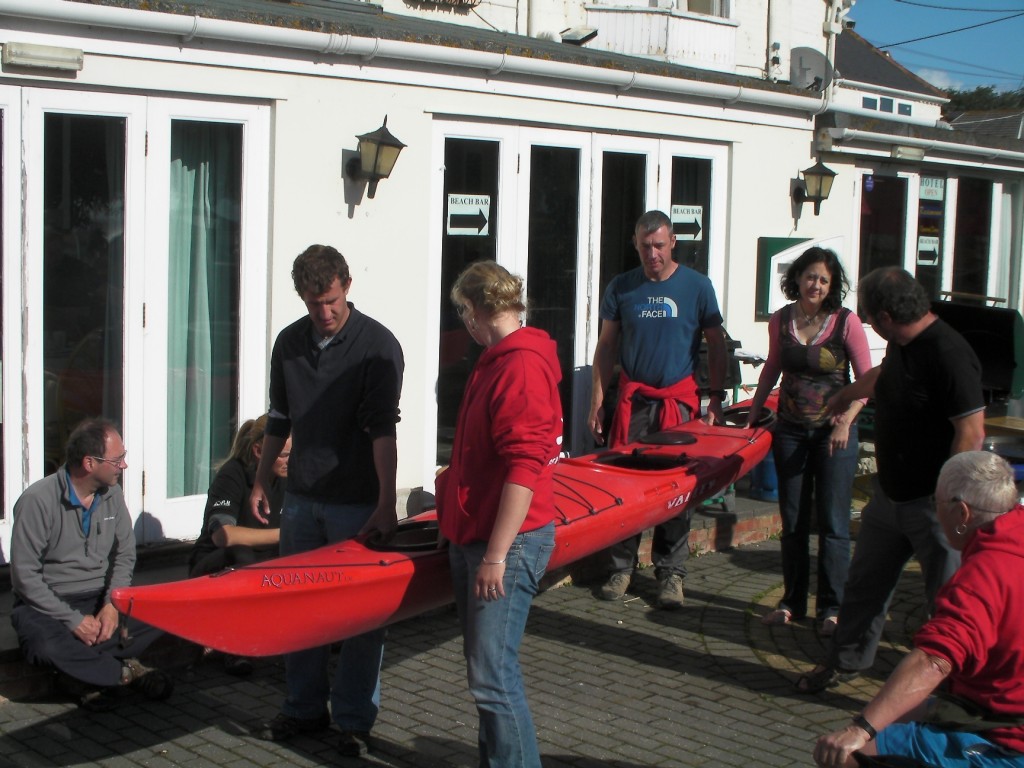
Bank Holiday Monday saw most of us split up into different workshops and I did an all day incident management session with Jeff Allen and Phil Hadley which was excellent. Miranda and Toons opted for the open water tidal planning course and Jac fell in love with a set of wings after her forward paddling session.
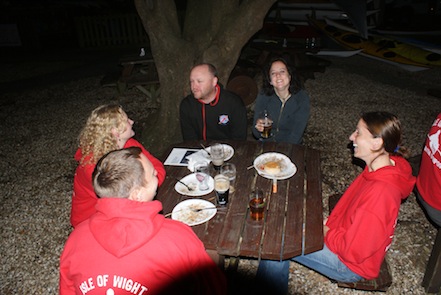
The symposium was organised not just for us paddlers but also to help raise money for the Freshwater Independent Life Boat Service.
The event was felt to be such a success that Isle of Wight Sea Kayaking already plan to organise a second one at the end of August next year. It will then alternate tnereafter every other year with the Skye Symposium which will take place in 2013 (or that is the plan anyway).
Phil
Saturday 13th August 2011
In sea paddling terms can the Kent coast be compared to say Cornwall or Pembrokeshire or even Dorset for that matter? No, possibly not but in its own way it is unique and even has some great paddling gems if you go looking for them and you get your tidal planning right. Given our London base you’d think the Kent coast would feature as a regular trip destination – in reality though the Club had only previously paddled along sections of it twice before. The previous paddles saw us paddle out of Sandgate (near Folkestone) to Abbot’s Cliff and meet Mungo Francis (quite accidentally as it happens) last summer and more recently in April we paddled 5 miles out and back from Herne Bay to the wind turbines. I was responsible for planning and organising both those trips and as I have a bit of an affinity to Kent (I am after all technically a “Kentish Man”) I thought it was about time another was organised.
For some time I’d had it in mind to organise a paddle along the eastern most tip of Kent from Ramsgate to Margate (or vice versa) – ok those locations are not particularly great but the coastline between the two takes in the seven sandy bays of Broadstairs. Each bay has its own character – the northern most of these bays is Botany Bay and is famous for its chalk stacks, Joss Bay is a popular surf beach and more importantly Kingsgate Bay has a chalk arch (which can be paddled through if the tide is right!).
After checking some local knowledge with Rob Davis I set about planning an outline trip – which was a 14km paddle round North Foreland from Ramsgate to Margate or the other way from Margate to Ramsgate with the aim of getting to Kingsgate Bay around high tide (or thereabouts) to go through its arch. I then set about looking at the tidal information (tide times and tidal streams) for the best date – and Saturday 13th August it was with Ramsgate as the launch location! The tidal streams were not completely perfect and after discussing things with Keith we agreed we had to be past Foreness Point by 2pm to avoid paddling against a significant current to the finish at Westbrook. The weather was the other factor – the forecast was for SW winds at the top end of a Force 4. If the weather and conditions got too bad during the trip the route had plenty of “pull off” locations. Plan B was a skills session if the weather really kicked up!
After a very early start we all eventually managed to rendezvous at a large carpark in Ramsgate (just north of the marina). There were nine of us and as it happened it was also Mel’s first time on the briney blue and Abdul’s first ever Club trip. The usual faff ensued as boats were unloaded and packed, etc and the drivers dashed away to do the shuttle – consequently we were about three-quarters of an hour late launching than planned. It was also pretty miserable – cold, raining and overcast.

We were launching into moderate surf with SW Force 3 winds (yep, Keith got his wind meter out to check). I launched first through the waves to an area beyond the significant swell and each person in the group followed one at a time with Keith being the last to launch. Although several white knuckles and interesting facial expressions were observed the launching was “incident free” and we were off heading northwards (rather quickly as it happens with the tide and the wind).
The coastline sped by and as we moved northwards the sea settled down and the sky became increasingly blue! Paddling effortlessly we reached Joss Bay and saw the Kingsgate Bay chalk arch ahead in the distance. Olwen and Keith checked out the surf in Joss Bay whilst the rest of us paddled on – fingers crossed I’d timed it right so we could pass through the arch – and luckily I had!

After agreeing the hand signals and setting up “lines of sight” most of the group took the opportunity to pass and re-pass through the arch timing the swell accordingly – a great bit of experience for several in the group.

Paddling on we passed the famous chalk stacks of Botany Bay and looked for a landing site for a lunch stop – ideally one that would be less prone to significant surf. We decided on an area just to the north of Foreness Point. Richard, Jac and Keith also decided to have a bit of a swim having been enticed by the clean sea and shining sun.


As we had around an hour to kill Keith proposed a skills session involving deep water rescues, self-rescues and rolling. It is easy to forget that skills such as these will diminish over time if you do not regularly practice them and the chance to do this in warm clean water was a welcome opportunity that could not be passed up by most in the group.

The group rounded Long Nose Spit and headed west to the finish point at Westbrook (just beyond Margate). Keith and I knew that we would have a bit of a current against us – nothing compared to what the group is used to as they all paddle regularly on the tidal Thames. What we hadn’t bargained on was for the wind to kick round more to the west so the journey to the finish was a bit more of a slog than we’d thought. But then Tim did say that the paddling had been way too tame up to that point – that’s karma for you I guess!
Off the water we got changed and loaded the boats onto the trailer as quickly as possible and most of the group headed back to Ramsgate in search of fish and chips – which turned out to be amazing and to quote Jacquelin the “best she’d had since she’d been in the UK” – before heading back to London.
Phil
5 – 7th August 2011
After paddling over 80km from Marlow to Chelsea in two days the previous weekend I was looking forward to what was meant to be a relatively relaxed paddle along the River Bure in Norfolk in good company and good weather. Well… we I guess two out of three ain’t bad I suppose…
Whilst CKC focuses on sea kayaking and touring we don’t get very many opportunities to do open boating (given we don’t have any of our own). So on the general principle that we should run an open canoeing trip at least once a year we were on the lookout for self-guided options. We decided to book a self-guided open canoe camping trip through The Canoe Man after seeing them at The Outdoors Show in January.
We rendezvoused at The Goat Inn in Skeyton ready to be met to be taken to the “get in” at Aylsham. There were eleven of us in total – including a few “firsts” for some people. It was Katie’s first CKC trip of the year, Pia and Bunny’s first CKC trip ever!, and also Pia’s first ever time in an open boat (it’s not big in Denmark apparently).
Most of us had camped over the previous night at The Goat Inn – and due to a communications cock-up on the part of The Canoe Man we had to stay in tipi’s as there was not enough room to pitch our own tents – which initially we were quite pleased about (i.e. no faff with tents, etc) until it started raining. Yep it turns out that the tipi’s were not very water tight and as we weren’t warned about this some people and kit got a bit wet during the night…
Saturday morning started out pretty miserable and we were all a bit concerned that it was going to set in all day. After a bit of faff the boats were loaded, people deciding who their tandem partners would be (tandem open boats are not called “divorce boats” for nothing…), and a short briefing we were off with the weather improving each hour! Did I mention that Bunny was paddling solo – yep as ever he wanted a challenge (he would however be regretting it by the end of the day).


Did I also mention that this was supposed to be a relaxed paddle? Well the first days paddle was meant to be around 15km (or thereabouts) to the wild campsite. The second day we could decide how long or short we wanted the paddle. With this in mind we progressed along the river figuring we could have a chilled lunch stop at the pub at Coltishall. As we progressed and tackled each portage with ever growing frustration (including having to deal with a rather irate home owner in Buxton Mill who had an issue with us getting out where the briefing sheets told us to) it became apparent that something was wrong… This was on top of the fact that Toons was repeatedly moaning that this was the “worst trip ever!”
Still there was a bit of a comedy moment as we were putting back into the water below Buxton Mill – being the cheeky chappy that Gieve is he wanted to do a short seal launch – “no, no, no!” pleaded Pia – “yes, yes, yes” Gieve said. The next thing we heard was a scream, a splash and Stu laughing his head off as the boat had in fact turned over and Gieve and Pia had taken a plunge along with all their kit!
We paddled on and it wasn’t until we got to Coltishall around 5pm (or thereabouts) absolutely starving and Toons and I looked at the sheets we noticed that there were distances along the bottom… It turns out that The Canoe Man had messed up yet again! We were meant to actually start the trip at Buxton Mill not Aylsham! Consequently we’d already done 16km and still had another 11km to go! Therein lies a lesson for me – do not necessarily trust everything a provider says – do your own due-diligence as well!

Still no real dramas and with a quiet determination we paddled on as fast we could in an attempt to get to the wild campsite before dark. The group split Jac and I, Kate and Stu, Gieve and Pia and Bunny found ourselves at the front and Toons, John, Katie and Miranda had dropped behind quite a way. As we reached Wroxham to phone The Canoe Man for some directions to the wild campsite – we heard mass grunting which then broke into songs as Toons and Katie had rafted alongside John and Miranda to create a “Ca-ta-noe”. By this time I should perhaps mention that Bunny was lagging too – finally we had found something that had broken him!

Pulling into Wroxham Broad we eventually found the wild camp location, pulled the boats up, pitched the tents, chatted around the disposable BBQ we had bought with us, and settled in for the night – yep we were absolutely knackered! We had paddled the best part of 27km and had tackled 4 portages.
The group awoke to a fabulous day and had a very slow start to breaking camp and getting away – much to Bunny’s frustration. A decision was made to go for the shorter paddle and had a nice and relaxed 6km paddle in the sun to The Swan Inn at Horning including a stop along the way for a “99” from an “ice cream boat” (!?!) and various attempts by some to ride the wake of the Sunday day-trippers.



Although there were some cock up’s the trip ultimately went well and The Canoe Man’s equipment and team on the ground were excellent. At the end of the day everyone had a great time (helped by what turned out to be amazing weather) and we will definitely be doing another self-guided canoe camping trip next year – suggestions on location anyone?
Phil
30-31 July 2011
There’s nothing quite like the ‘home stretch’ whenever you’re out paddling – the optimism, the burst of speed, the feeling of ‘nearly there’. Well on this trip we had two whole days of home stretch as we shuttled eight of the club boats 52 miles up river on the CKC trailer to Marlow and planned to paddle them home all the way back to Cremorne Riverside.
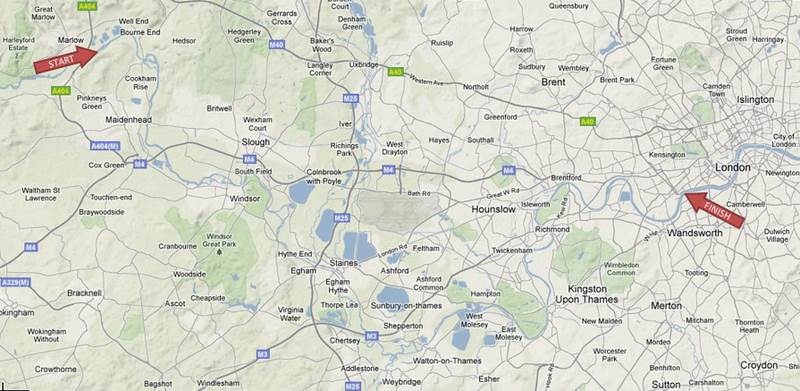
Dave Tuttle came up with the ingenious plan, as a way to get to see what the rest of the Thames looked like – the non-tidal part – and as a way of potentially ticking off a chunk of a later source to sea challenge?
Thanks to my nephew who played shuttle-bunny and dropped Dave and I, along with the kit and boats off at the riverside slipway in Marlow (at the crack of dawn!), minimal faffing was required and when the other guys rocked up via train and taxi we swiftly packed boats and made it on the water for an impressive 9am launch. However, we were only paddling for about 4 minutes before we had to stop and wait for our first lock – which was good as it gave us time to slap on some extra sun cream, as the day was looking to be hot!
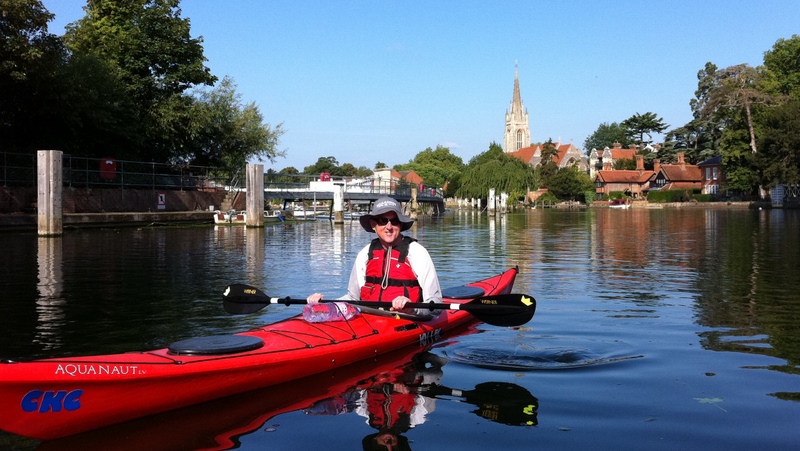
Thankfully most of the Thames locks are manned during the day, so all we had to do was paddle on in when instructed after the motor boats and barges. Sitting in a sea kayak when in a lock is a surreal experience – the first time you do it – but by the end of this trip we were all dab hands at it (the trick I found is not letting the stern of your boat get caught on the steps as the water drops!). We also became quite adept at leaving a CKC tag in the locks we passed through with a bit of ‘sludge graffiti’ as the water level dropped beneath us. Stu and Kate had to go one further and mark their own personal journey down the Thames… but I guess each to their own?
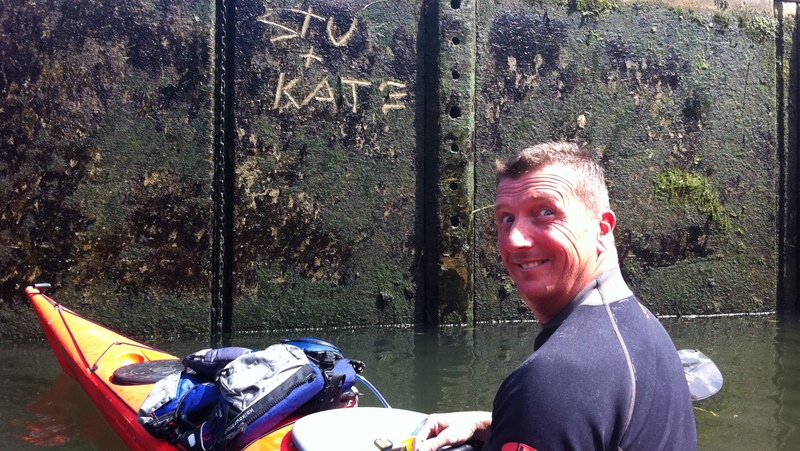
Dave had heard of a nice couple of pubs that nestle against the banks of the river, just down from Marlow – and as it was still pretty early we all convinced ourselves that a hearty pub-breakfast and a cuppa coffee would be a good way to start the weekend. Unfortunately it was so blooming early that none of these pretty little places were open or serving food as we forlornly paddled up to each of them.
In hindsight it was probably a good thing that we didn’t stop, as we had a long way to go that day – 26 miles in fact – and with only around 0.5 knots of current to help us along, it was going to be a tough slog. So we continued onwards and started making friends with some of the pleasure boaters who we played leapfrog; they zoomed by us, only to be caught up again at the next lock as we all waited for entry. Something that added a considerable chunk of time to our meticulously planned schedule as it took longer than Dave thought it might to clear each one – if you turned up at the wrong time.
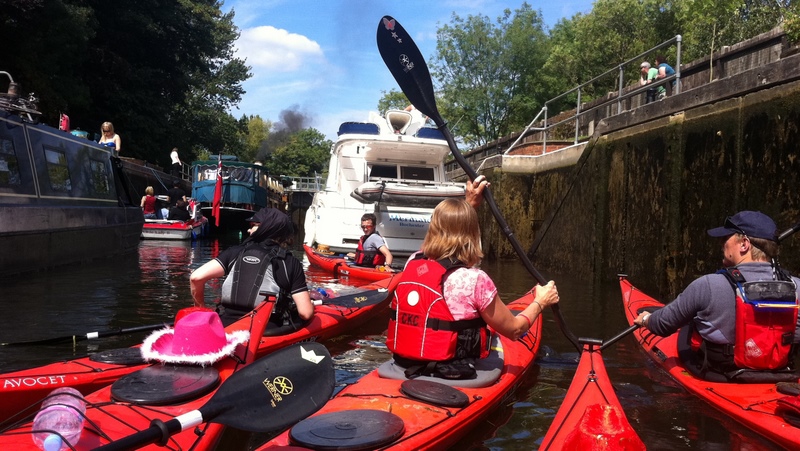
Randomly we managed to acquire some red and pink cowboy hats for everyone – so not only did they raise eyebrows and ice-breaker questions from the passing boats, but provided some much needed protection and shade from the sunshine – bonus!
It was late morning by the time the countryside tow-paths gave way to the manicured gardens of the uber rich that stretched down from grand houses on the both banks of the Thames in the Maidenhead area. So not wanting to seem common, Dave was all too keen to say hello to a man he saw sitting on his private pontoon – it wasn’t until after the life-size papier mache gnome failed to respond did he realise his mistake and look quickly over his shoulder to see if the rest of us had noticed his blunder (we did and mocked him for it!!).
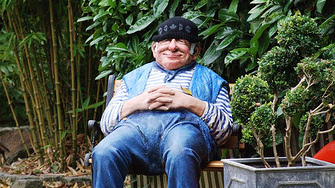
It was in this neck of the woods (or should I say topiary) that we also came across a bunch of Canadian canoes pootling along the river, lazily taking in the sites and gawping at the splendour (and cost) of these houses! In our speedy sea kayaks it didn’t take us long to catch them up and introduce ourselves and have a chat with Hastings Canoe Club, who were doing a similar trip – but over four days instead of two.
Shortly after that we said our goodbyes and carried on, with the prospect of a lunch stop some-time soon, it wasn’t until we started to see the outskirts of Windsor that we found a suitable landing to get out and stretch our legs.
Back on the water we carried on downstream amid the hundreds of ducks and swans, skirted by the island based Windsor Racecourse and then down a cheeky ‘short cut’ which lead us passed some hillbilly lookalikes and into tumble of fallen trees across the river. With a few limbo manoeuvres we made our way through and came out facing a whole load of people sitting on the riverbank and drinking in pubs near Windsor Town. Around the next bend we arrived at the ‘no mooring’ signs or the Royal grounds attached to the back of Windsor Castle itself, a beautiful stretch of river that sadly was spoiled by the noise of the planes heading into Heathrow.
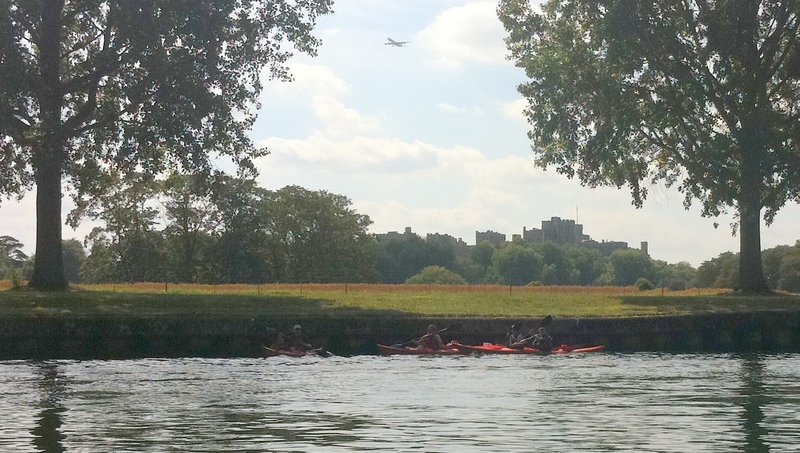
By now the heat (and length) of the day was starting to get to us and we desperately wanted a beer – but it would seem that it would be some time yet before we could break for a pint as there were no pubs to be seen. After eagerly asking one Lock Keeper we got told of a Harvester some two miles further down river, they were probably the quickest two miles of the day at the speed we paddled. Although a bit of a dive, the beer was cold and much appreciated (even though the first one barely touched the sides).
Rested and watered we cracked on and, much like buses, now came across pub after pub along the banks. The hesitation we had about Staines proved to be in vain as we were pleasantly surprised it ‘looks alright’ from the river – especially the pub we spotted after passing under the bridge. With our campsite supposedly just 30 mins away we stopped for another quickie pint and to appreciate the late evening sunshine with a load of locals. Much to Olwen’s delight they served ‘Tea’ (by the pint) and Tim was also impressed that he could get a pint of ‘Semen’ – or something like that?!
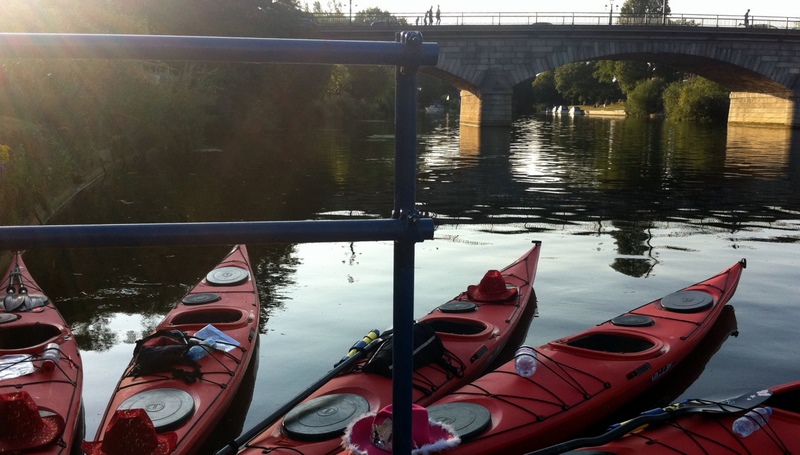
We reached our designated campsite near Laleham as the sun was making its final descent below the horizon and swiftly pitched tents, showered and headed over to yet another pub, where we made last orders for food by the skin of our teeth. Not surprisingly after a full-on day paddling we were all pretty shattered and were heading back to our tents soon after for well-earned snooze.
As Sunday dawned we all got up in good time and de-camped everything back into the hatches on our sea kayaks, ready to head off after we’d had hearty breakfast at the campsite café. It was at this point we discovered that the café had been fire-bombed and it would be another morning without brekky – so we shared what rations we had left and set off in search of the next open pub or café down the river.
We passed through Chertsey and a good part of Shepperton before we rocked up at the Thames Court – only to discover we had to wait for the lunch menu before we could eat. Not wanting to risk the wrath of a hungry Stu, we waited and watched as suddenly hundreds of people emerged to make the most of the sunshine and a nice pub lunch (unfortunately it wasn’t that nice!).
After Shepperton we headed on towards Hampton Court, but as we went by Sunbury there seemed to be a flurry of river traffic, so Olwen, Tim and I hitched a lift on the wake of a small motorboat towing a kid on a rubber ring. After a day and a half paddling the small surfing rest bite was well received and thanks to that kid’s help we all made it down to see the Hampton Court Palace gilded gates rested and eager to go.
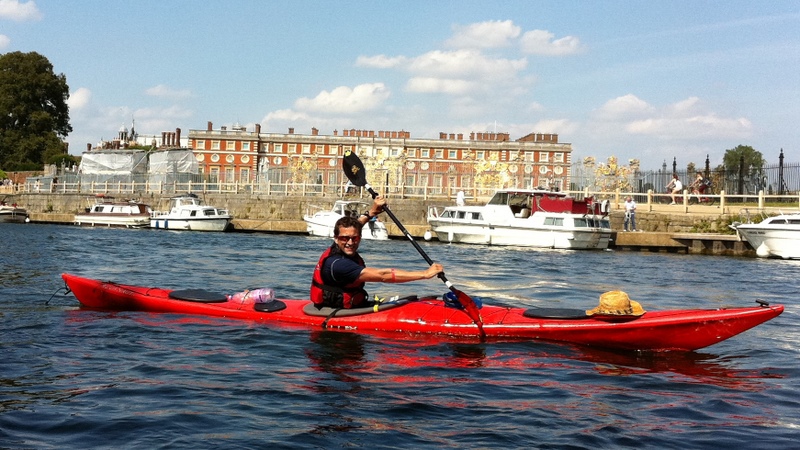
After that, the river towns and river started to feel more familiar to us Londoners, as we passed Thames Ditton, Kingston and then Richmond. We became so relaxed and settled into our paddle stroke that it wasn’t until after a flock of geese nearly decapitated Kate as they v’d along the river did we start to pay attention at what was going on around us again.
Thanks to Dave’s planning – and a perseverance to paddle onwards by the team – we reached Teddington Lock bang on high-tide, so were actually able to shoot the 4 inch drop down the weir with barely a scrape to our hulls. The cut-thru on the weir also happened to place us nearer to our designated lunch spot – The Anglers pub. However mutiny occurred when Phil spotted a massive sign for Cream Teas at the place next door – so we split up into two contingents; one for beer and one for tea, only to regroup and ride the tide back to Cremorne half an hour later.
We were suddenly making a stonking pace, as we let the ebbing tide add a few knots to our regular paddling tempo, helping us zip passed Kew, Barnes and Hammersmith. Now we really were on the ‘home stretch’ – water we regularly paddle during the evening sessions, so it didn’t take long to but those last few miles under our belt. It was around 5pm that we made it back to base, with triumphant grins all around – we’d done it, two marathon paddles in two days!
So, in summary, our trip in numbers:
- 52 miles
- 48 bridges
- 11 locks (taken)
- 8 Kayakers
- 3 Limbos
- 6 tents
- 2 portages (at locks)
- 1 weir (run in boats)
John
|
|
![]() . And I must admit that I changed my mind several times during the discussion, when new views came into consideration ;-).
. And I must admit that I changed my mind several times during the discussion, when new views came into consideration ;-). ![]() Thank you so much, Jonny!).
Thank you so much, Jonny!). ![]() .
. 


![]() .
. 
![]() .
. 
![]() ) until sunset and then everybody was occupied by cooking the most fabulous dinner I’d had for a long time! Paul was in charge of producing a fantastic Fish Pie and Fiona brought apples for a delicious Apple Crumble Recipe! And I trust that I wasn’t the only one who could hardly eat anything the next day.
) until sunset and then everybody was occupied by cooking the most fabulous dinner I’d had for a long time! Paul was in charge of producing a fantastic Fish Pie and Fiona brought apples for a delicious Apple Crumble Recipe! And I trust that I wasn’t the only one who could hardly eat anything the next day.
![]() )
)
